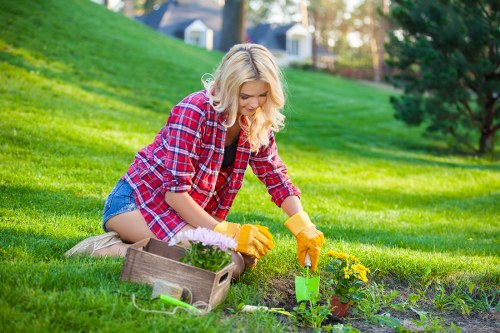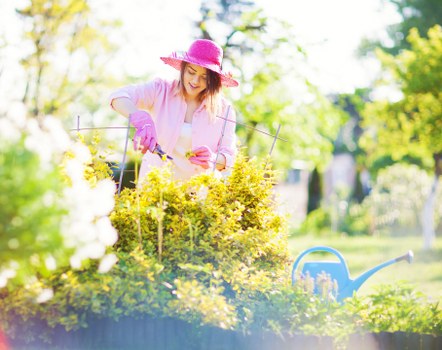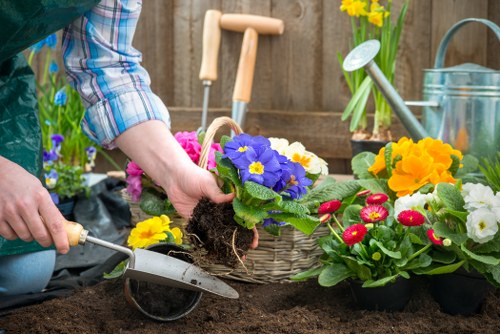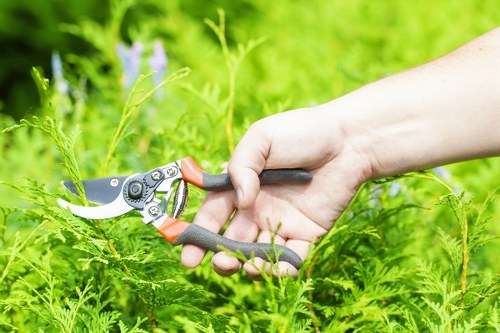Transform Your Outdoor Spaces with Landscape Gardening in Wood Green
Introduction to Landscape Gardening

Landscape gardening in Wood Green is more than just planting flowers and shrubs; it's about creating a harmonious and aesthetically pleasing outdoor environment tailored to your lifestyle and preferences. Whether you have a sprawling garden or a compact balcony, professional landscape gardening can enhance the beauty and functionality of your space.
Wood Green offers a unique climate and soil conditions that can influence your gardening choices. Understanding these local factors is essential for selecting the right plants and design elements that will thrive and remain vibrant throughout the year.
Professional landscape gardeners in Wood Green bring expertise in designing, planning, and maintaining gardens that not only look stunning but also add value to your property. From sustainable gardening practices to innovative design solutions, they cater to a wide range of gardening needs.
Benefits of Landscape Gardening

Investing in landscape gardening offers numerous benefits:
- Enhanced Curb Appeal: A well-designed garden can significantly boost the visual appeal of your home.
- Increased Property Value: Beautiful landscaping can increase the market value of your property.
- Environmental Benefits: Gardens can improve air quality, reduce carbon footprints, and support local biodiversity.
- Personal Well-being: Spending time in a beautiful garden can reduce stress and improve mental health.
In Wood Green, where community and outdoor living are highly valued, a thoughtfully landscaped garden can also provide a space for social gatherings and relaxation.
Moreover, landscape gardening can be tailored to incorporate sustainable practices, such as rainwater harvesting, composting, and the use of native plants, contributing to a greener environment.
Planning Your Landscape Garden

Assessing Your Space
Before embarking on your landscape gardening project, it's crucial to assess the available space. Consider factors such as:
- Sunlight Exposure: Determine which areas receive full sun, partial shade, or full shade.
- Soil Quality: Test the soil to understand its pH levels and nutrient content.
- Existing Structures: Take note of existing buildings, pathways, and utilities that may influence the design.
Choosing the Right Plants
Selecting the appropriate plants is fundamental to the success of your landscape garden. In Wood Green, it's advisable to opt for plants that are:
- Native: Native plants are well-suited to the local climate and soil, requiring less maintenance.
- Drought-Resistant: Plants that can withstand periods of dry weather are beneficial, especially during summer months.
- Seasonal: Incorporate a variety of plants that bloom in different seasons to ensure year-round interest.
Professional landscapers can help you choose the best plant species that align with your aesthetic preferences and sustainability goals.
Design Elements in Landscape Gardening

Hardscaping Features
Hardscaping elements add structure and functionality to your garden. Common hardscaping features include:
- Patios and Walkways: Provide pathways and outdoor living spaces.
- Retaining Walls: Help manage sloping terrains and create level planting areas.
- Water Features: Fountains, ponds, and waterfalls add a soothing auditory element.
Softscaping Components
Softscaping refers to the living elements of your garden. This includes:
- Plant Selection: Trees, shrubs, flowers, and ground covers.
- Mulching: Helps retain soil moisture and suppress weeds.
- Lawn Areas: Provide open spaces for recreation and relaxation.
Balancing hardscaping and softscaping creates a cohesive and inviting outdoor environment.
Maintenance Tips for Your Landscape Garden

Regular Care
Maintaining your landscape garden involves regular care and attention. Key maintenance tasks include:
- Watering: Ensure plants receive adequate water, adjusting for seasonal changes.
- Pruning: Trim overgrown branches and remove dead or diseased foliage.
- Weeding: Keep the garden free from unwanted plants that can compete with your desired vegetation.
Seasonal Maintenance
Each season brings its own set of maintenance requirements:
- Spring: Prepare the garden by clearing debris and planting new growth.
- Summer: Focus on watering and controlling pests.
- Autumn: Harvest remaining produce and prepare plants for winter.
- Winter: Protect sensitive plants and plan for the upcoming gardening season.
Implementing a seasonal maintenance schedule ensures the longevity and health of your landscape garden.
Choosing the Right Landscape Gardening Services in Wood Green
Factors to Consider
Selecting a reputable landscape gardening service is crucial for achieving your desired outdoor space. Consider the following factors:
- Experience: Look for companies with a proven track record in landscape gardening.
- Portfolio: Review their previous projects to gauge their design style and quality of work.
- Customer Reviews: Testimonials and reviews can provide insights into their reliability and customer satisfaction.
- Services Offered: Ensure they provide comprehensive services, from design to maintenance.
Consultation and Planning
A good landscape gardening service will offer a thorough consultation process. They should assess your space, discuss your preferences, and provide a detailed plan outlining the design and implementation stages.
Clear communication and collaboration are essential to ensure the final outcome aligns with your vision.
Popular Plants for Wood Green Gardens
Flowering Plants
In Wood Green, certain flowering plants thrive and add vibrant colors to your garden:
- Roses: Classic and versatile, roses come in various colors and fragrances.
- Lavender: Known for its aromatic properties and beautiful purple hue.
- Hydrangeas: Produce large, showy blooms that add a splash of color.
Evergreens
Evergreen plants provide year-round greenery and structure to your garden:
- Boxwood: Ideal for hedges and topiary.
- Juniper: Adds texture and serves as excellent ground cover.
- Pine Trees: Offer height and a natural backdrop.
Incorporating a mix of flowering plants and evergreens ensures your garden remains attractive in all seasons.
Sustainable Landscaping Practices
Water Conservation
Implementing water conservation techniques is essential for sustainable landscape gardening:
- Irrigation Systems: Install drip irrigation or smart watering systems to minimize water waste.
- Rainwater Harvesting: Collect and store rainwater for garden use.
- Mulching: Reduces evaporation and maintains soil moisture.
Native Plant Selection
Choosing native plants supports local ecosystems and reduces maintenance:- Native plants are adapted to the local climate and soil conditions.- They require less water and are more resistant to local pests and diseases.- Support local wildlife, including pollinators like bees and butterflies.
Composting and Soil Health
Maintaining healthy soil is the foundation of a thriving garden:
- Composting: Recycle organic waste to create nutrient-rich compost for your plants.
- Soil Testing: Regularly test soil pH and nutrient levels to ensure optimal plant growth.
- Organic Fertilizers: Use natural fertilizers to promote healthy plant development without harming the environment.
Adopting these sustainable practices not only benefits your garden but also contributes to environmental conservation.
Designing Outdoor Living Spaces
Patios and Seating Areas
Creating comfortable outdoor living spaces enhances your garden's functionality:
- Patios: Serve as the perfect area for dining and entertaining.
- Seating Areas: Incorporate benches, lounges, or pergolas for relaxation.
- Fire Pits: Add warmth and a focal point for evening gatherings.
Outdoor Kitchens
Outdoor kitchens allow you to enjoy cooking and dining alfresco:
- Grills and Cooktops: Essential for preparing meals outdoors.
- Counter Space: Provides ample area for food preparation and serving.
- Storage: Keep cooking utensils and supplies organized and easily accessible.
Integrating these elements into your landscape design creates a seamless transition between indoor and outdoor living spaces.
Lighting Your Landscape Garden
Types of Garden Lighting
Proper lighting enhances the beauty and safety of your garden:
- Path Lighting: Illuminates walkways and prevents tripping hazards.
- Spotlighting: Highlights key features like trees, statues, or water features.
- Ambient Lighting: Creates a warm and inviting atmosphere in outdoor living areas.
Energy-Efficient Options
Choose energy-efficient lighting solutions to reduce energy consumption:
- LED Lights: Long-lasting and consume less power compared to traditional bulbs.
- Solar-Powered Lights: Harness solar energy, eliminating the need for wiring.
- Motion Sensors: Activate lights only when movement is detected, conserving energy.
Incorporating these lighting options ensures your garden is both beautiful and eco-friendly after dark.
Seasonal Garden Care in Wood Green
Spring Maintenance
Spring is a time of renewal, and your garden requires specific care:
- Cleaning: Remove debris and dead plants from winter.
- Planting: Introduce new plants and flowers to usher in vibrant colors.
- Fertilizing: Boost plant growth with appropriate fertilizers.
Summer Care
During summer, focus on maintaining healthy plants:
- Regular Watering: Ensure plants receive adequate moisture, especially during heatwaves.
- Pest Control: Monitor for pests and treat infestations promptly.
- Pruning: Trim plants to promote air circulation and prevent disease.
Taking these steps helps your garden thrive even in the peak of summer.
Winterizing Your Garden
Protecting Plants
Winter can be harsh on your garden, requiring measures to protect your plants:
- Mulching: Apply mulch to insulate plant roots from freezing temperatures.
- Covering Sensitive Plants: Use frost blankets or covers for plants that are not winter-hardy.
- Pruning: Remove dead or damaged branches to prevent breakage from snow and ice.
Preparing for Spring
Use the winter months to plan and prepare for the next gardening season:
- Garden Planning: Assess what worked well and what didn't in the previous season.
- Tool Maintenance: Clean and repair gardening tools to ensure they're ready for spring.
- Seed Starting: Begin sowing seeds indoors for early planting.
Proper winterizing sets the stage for a successful and vibrant garden in the coming year.
Integrating Technology in Landscape Gardening
Smart Irrigation Systems
Embrace technology to make your garden more efficient:
- Automated Timers: Schedule watering times based on plant needs.
- Weather Sensors: Adjust irrigation based on rainfall and temperature changes.
- Remote Control: Manage your irrigation system from your smartphone.
Garden Management Apps
Leverage mobile applications to plan and manage your garden:
- Plant Identification: Identify unknown plants and receive care instructions.
- Garden Planning: Design your garden layout and track plant growth.
- Pest Control: Get alerts and solutions for pest infestations.
Integrating these technologies can simplify garden maintenance and enhance productivity.
Conclusion
Your Dream Garden Awaits
Landscape gardening in Wood Green offers endless possibilities to create a beautiful and functional outdoor space tailored to your needs. By understanding local conditions, selecting the right plants, incorporating sustainable practices, and utilizing modern technologies, you can transform your garden into a haven of tranquility and beauty.
Whether you're starting from scratch or looking to enhance your existing garden, professional landscape gardeners in Wood Green are equipped to bring your vision to life.
Contact us today to begin your journey towards a stunning landscape garden that you and your family can enjoy for years to come.
Book your service now and take the first step in creating the garden of your dreams.
